Consistently productive, unpretentious and disease-resistant garlic “Lyubasha” - we grow it on our own plot
Garlic is one of the most popular types of vegetables in the world. It has dozens of varieties, so you should first read the description of the crop, and then choose the one most suitable for your climate and growing conditions.
Among the most famous winter varieties is Lyubasha garlic. Farmers leave mostly positive reviews about it; they grow it in various regions.
Description of the garlic variety Lyubasha
Garlic variety Lyubasha reaches a height of 1.5 m. The leaves are dense, about 50 cm long and up to 2.5 cm wide. Covered with a slight waxy coating. They have a pleasant taste with a slight pungency. Because of this, they are often used in salads.
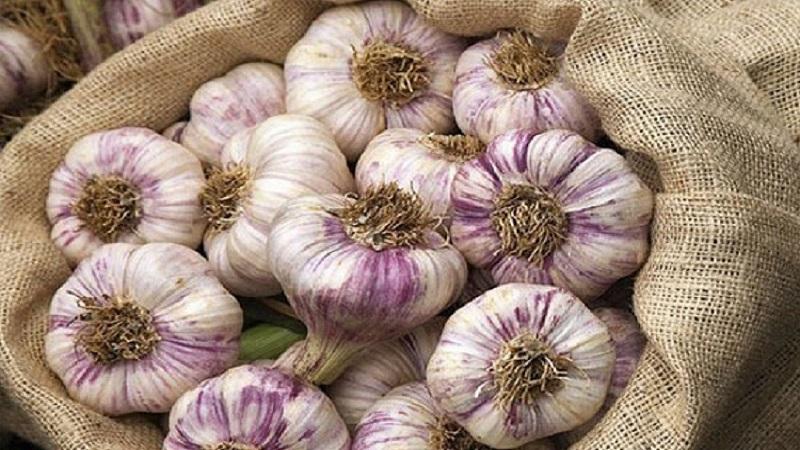
The weight of the head ranges from 80 to 120 g. Each of them contains 7 cloves. The cloves are covered with a white shell with a slight pink tint. The outer scales are white with purple veins.
This winter garlic is perfectly stored and does not spoil for 11 months.. At the same time, all vitamins and microelements are preserved in it.
Read also:
How to use garlic correctly so as not to harm your health
Distinctive features
Basic differences between Lyubasha garlic and other varieties:
- Growing in any climate zones and regions.
- Ability to maintain presentation for 10-11 months.
- Storage 10–11 months.
- Tolerance of long-term transportation.
- Cold resistance.
- Resistance to harsh weather conditions.
- Garlic tolerates lack of moisture more easily.
- Resistant to pests, fungal diseases and fusarium.
- Not demanding in care.
Attention! The Lyubasha variety has no serious disadvantages.
Productivity
The yield of Lyubasha garlic per hectare is 15-20 tons, from one hundred square meters - 150-200 kg. Moreover, the weight of one head ranges from 80 to 120 g.
Taste qualities
Garlic has a pleasant taste with a slight pungency. Because of this, it is often used in salads. Lyubasha has a persistent garlic aroma. Suitable for preparing dishes and storing canned food for the winter.
Composition and beneficial properties
Lyubasha garlic has a low calorie content – 100 g accounts for 45 kcal.
The product contains in sufficient quantities:
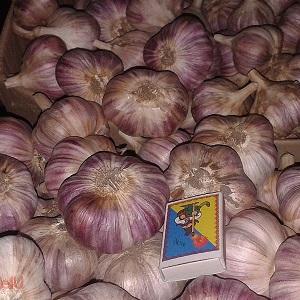 proteins;
proteins;- fats;
- carbohydrates;
- alimentary fiber;
- acids;
- essential oils;
- vitamins of various groups.
Lyubasha has special enzymes that help the human body fight serious diseases.
The culture is rich in a large number of useful substances: calcium, sodium, magnesium, potassium, nitrogen. This plant also contains sulfuric, silicic and phosphoric acids.
Important! Garlic forms active substances - phytoncides. The vegetable eliminates or suppresses pathogenic bacteria in the human body using biological enzymes.
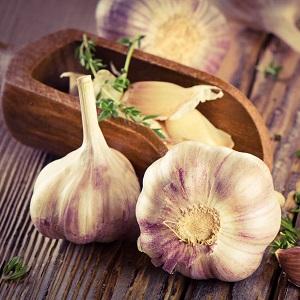 The plant is considered an analgesic and antiseptic.. Products containing it are applied externally to non-healing and festering wounds. Garlic is used to remove warts and calluses and treat inflammation after insect bites.
The plant is considered an analgesic and antiseptic.. Products containing it are applied externally to non-healing and festering wounds. Garlic is used to remove warts and calluses and treat inflammation after insect bites.
Allicin contained in garlic is a powerful bactericidal agent., destroying pathogenic bacteria.Entering the body, it relieves tension from the walls of blood vessels. This phenomenon has a positive effect on the functioning of the human cardiac system.
The vegetable is used in folk medicine to treat colds.. It is enough to eat one clove of garlic to eliminate harmful microorganisms in the oral cavity.
When consuming garlic in different forms, a person’s digestion is stimulated.. Due to the burning taste, abundant salivation is produced, which in turn leads to an increase in appetite. Garlic is used to treat hemorrhoids, flatulence, constipation and intestinal atony.
Regular consumption of garlic reduces bad cholesterol levels. As a result, plaques do not form on the walls of blood vessels. The vegetable is indicated for angina pectoris - it reduces the frequency of contractions of the heart muscle, while simultaneously increasing their amplitude.
Garlic has shown itself to be effective in treating frequent dizziness., sleep problems, poor memory. Unique components significantly alleviate pneumonia, bronchitis, flu, colds and bronchial asthma.
How to plant
Lyubasha garlic is a winter crop, so this variety is planted in the fall.. Planting dates depend on the climate zone and weather conditions - from late September to mid-November. The approximate time for planting vegetables is 2-3 weeks before the onset of the first frost.
Preparation of planting material and soil
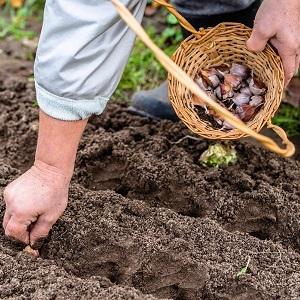 Eat two ways to plant garlic: cloves and heads.
Eat two ways to plant garlic: cloves and heads.
Before planting, the cloves should be disinfected with a solution of potassium permanganate. or copper sulfate. This stimulates the plant's immune system.
When planting Lyubasha garlic heads, it is recommended to sort them into fractions. Planting is carried out mechanically.You should also maintain a distance: between seeds - 10 cm, between rows - 40 cm.
Choose a well-lit place with a light soil texture and neutral acidity. This type of onion grows well on loam, but does not tolerate wet areas where water stagnates in the spring.
The beds where garlic is supposed to be placed are fertilized with manure (preferably horse), add phosphorus-potassium preparations and dig them up. In the spring, if necessary, the plant is additionally fed with nitrogen.
How to grow
Details Let's study the stages of cultivation.
Landing
Experienced gardeners It is recommended to plant garlic according to the following scheme: 1 plant for every 10 cm in a row and 30-40 cm between rows.
The optimal planting depth for Lyubasha garlic is 8-10 cm (the larger the size of the cloves, the deeper they are planted). After planting, it is recommended to mulch the beds with a layer of 4 cm. This is especially necessary in the northern regions, where frosts can lead to the death of plantings in winter.
Be sure to weed the soil and eliminate weeds, as they attract pests.
Care
The Lyubasha variety does not require special care. There are two requirements:
- removing weeds in the place where garlic is planted;
- timely watering of planted plants.
Attention! Unlike other varieties, Lyubasha garlic is suitable for any region and climatic conditions. It is more resistant to diseases caused by fungal microflora.
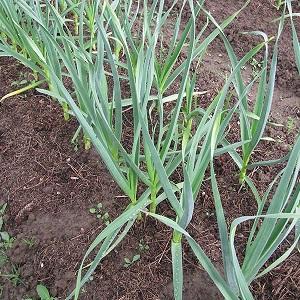 From mid-April, the crop needs regular watering. In this case, it is necessary to control the amount of moisture in the root system. Too much water will kill the garlic.
From mid-April, the crop needs regular watering. In this case, it is necessary to control the amount of moisture in the root system. Too much water will kill the garlic.
The vegetable tolerates drought well. But it is better not to allow the soil to dry out completely. It is optimal to water the crop at least 1-2 times a week.
To increase productivity, farmers recommend feeding Lyubasha 3-4 times per season, using complex mineral compositions for these purposes. Fertilizers are applied simultaneously with watering (it is best to dilute the preparations with water; in a dry form they are less easily absorbed).
The first feeding is carried out immediately after, as seedlings appeared on the surface of the earth. At this stage, you can use regular urea (20 g per bucket of water). If the bed is not mulched, it is useful to add organic matter, for example, mullein, to the mineral fertilizing.
The second feeding is carried out 2 weeks after the first. The fertilizer should contain potassium, phosphorus and nitrogen. A good option is “Nitrophoska” or “Nitroammofoska”. In a bucket of water you need to dilute 2 tbsp. l. substance and use it to water approximately 3 m² of bed.
More about garlic:
Diseases and pests
The Lyubasha variety is resistant to fusarium and other diseases and pests. But weakened plants may be attacked by:
- pathogenic microorganisms (downy mildew, bacteriosis, neck rot, black mold);
- pests (onion fly, stem nematode, onion hoverfly, secretive proboscis, root mite and others).
If there is slow feather growth during the growing season, this means that the plant does not have enough nutrition. To eliminate this problem, you need to feed with the following composition: 1 tablespoon of urea and 1 glass of bird droppings per 10 liters of water.
Gray-white feathers - a sign of lack of moisture, a pale green tint - excess moisture, watering should be limited.
Cleaning and storage
There are a number of basic requirements for collecting and storing the Lyubasha variety:
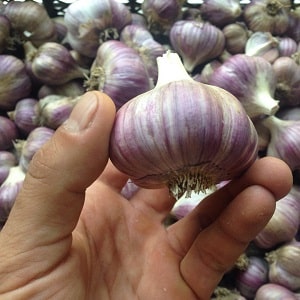 Garlic begins to be harvested in mid-July, but sometimes a little earlier. The first sign that a vegetable is ready for harvest is the yellowed tips of the leaves.
Garlic begins to be harvested in mid-July, but sometimes a little earlier. The first sign that a vegetable is ready for harvest is the yellowed tips of the leaves.- The harvest is harvested in dry weather. 1-2 weeks before this, it is necessary to stop watering, because the soil should not be very wet.
- The heads are dug out with a shovel, after which the remaining soil is shaken off.
- The garlic needs to dry, so it should be placed in a dark, ventilated place or hung from the ceiling.
- When the top husk has become dry, the stems are cut off, leaving a small neck.
- The harvested crop is placed in bags, nets or wooden boxes with holes. Store garlic in a ventilated area at a temperature not below zero.
- The crop is periodically sorted to prevent fungus or other diseases from appearing.
Areas of application of the crop
Lyubasha garlic is consumed fresh and dried, added to salads, baked dishes, used in cooking for pickling, pickling and preservation, and also as a seasoning. The vegetable is pickled as a separate product.
The culture has a large number of medicinal properties:
- fights pathogenic viruses, bacteria, microbes and fungi;
- accelerates the restoration of damaged tissues;
- increases the strength of contractions of the heart muscle;
- prevents the formation of cholesterol;
- reduces the risk of blood clots;
- relieves vasospasm;
- lowers blood pressure;
- for bronchopulmonary diseases, reduces inflammation of the mucous membrane of the respiratory tract, thins sputum;
- kills cancer cells in the oral cavity and bronchi, equivalent to chemotherapy;
- activates immune cells;
- helps the production of digestive enzymes;
- activates the gonads and disinfects the genitourinary system;
- Containing vitamin PP, it prevents senile dementia.
Advantages and disadvantages of the variety
The variety has a number of advantages:
- Lyubasha contains a large amount of vitamin C and other beneficial substances. It contains proteins, essential oils, amino acids, selenium and allicin.
- Garlic tolerates drought very well.
- High yield.
- Has good frost resistance.
- Resistant to diseases caused by fungi.
- Rarely affected by pests.
- Undemanding to soil quality.
The advantages of this variety allow it to be successfully grown in northern and arid regions. It consistently produces high yields.
The disadvantages are:
- mandatory intensive care to obtain a bountiful harvest;
- the need to remove arrows;
- pungent taste and large cloves of garlic.
If the above disadvantages are not important for you, feel free to grow the Lyubasha variety of garlic in your own area.
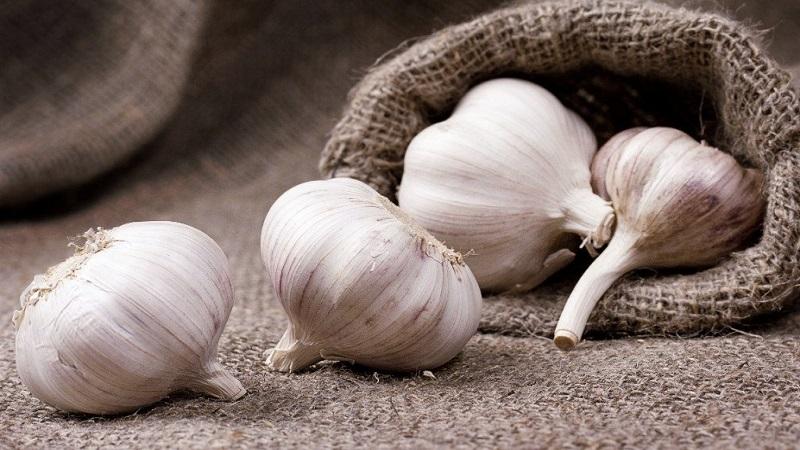
Farmer reviews
Reviews about Lyubasha’s garlic there are mostly only positive things. It is praised and admired for its frost resistance, drought resistance and stable yield.
Here are just a few reviews:
Alexandra: “Last year we bought Lyubasha garlic at the market from a private owner for winter planting. The garlic was small, approximately the same size and almost all had four cloves. Today we have harvested. Garlic has up to seven cloves in the head, and the weight reaches 120 g. The taste is excellent, and so is the keeping quality.”
Michael: “It may, of course, be a good year for garlic, but the Lyubasha variety just made us happy. Minimal care, moderate watering, loosening the soil. There was only one fertilizing with nitrogen fertilizer in early spring, no more chemicals. I grew 490 kg of garlic and found sales at the local wholesale market in Vinnitsa.”
Conclusion
Lyubasha's garlic is ideal for growing on an industrial scale. In addition to the fact that planting and caring for it is simple, the volume of the harvest is pleasantly surprising. If all rules are followed, up to 20 tons of garlic can be harvested from 1 hectare of land. That is why it has long been loved not only by summer residents, but also by entrepreneurs.